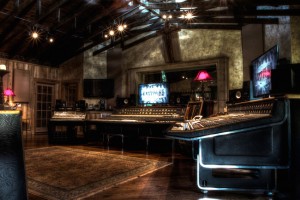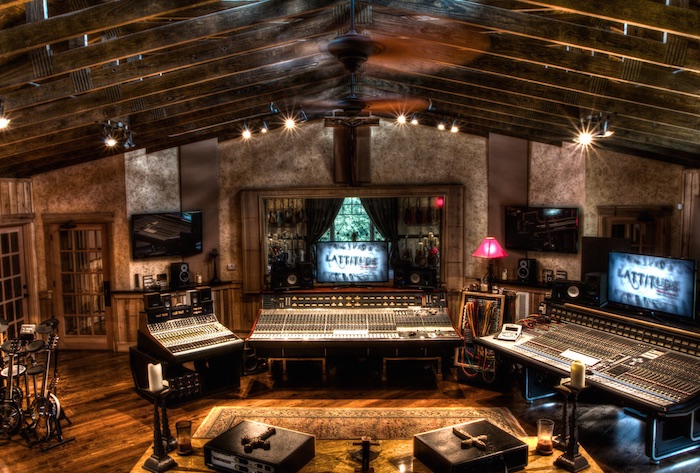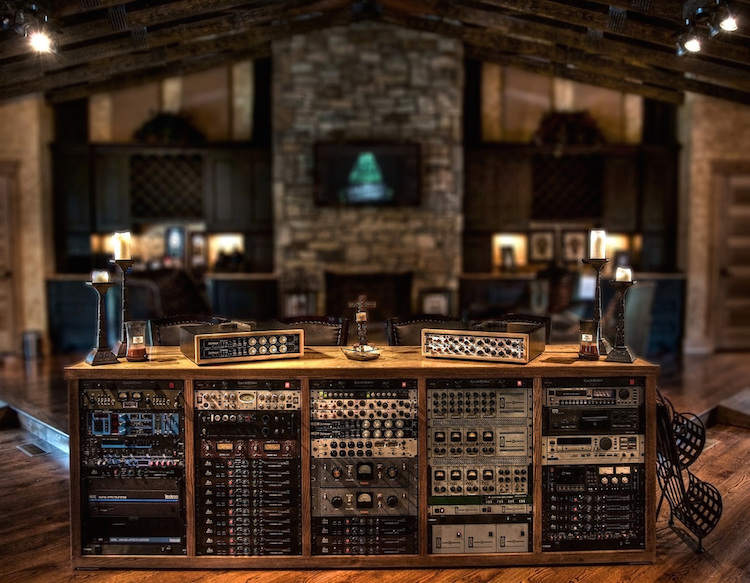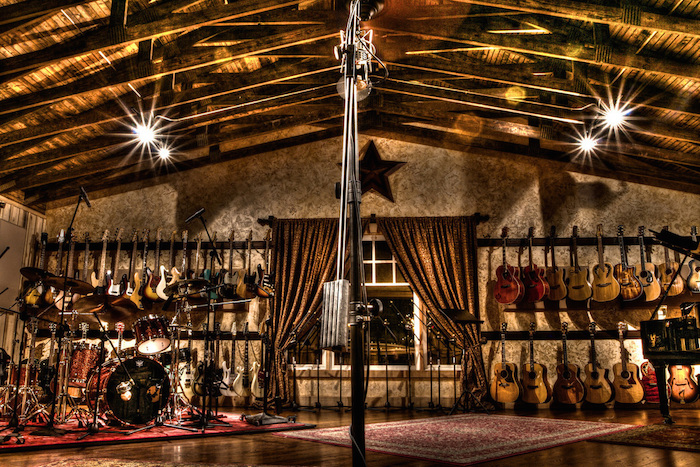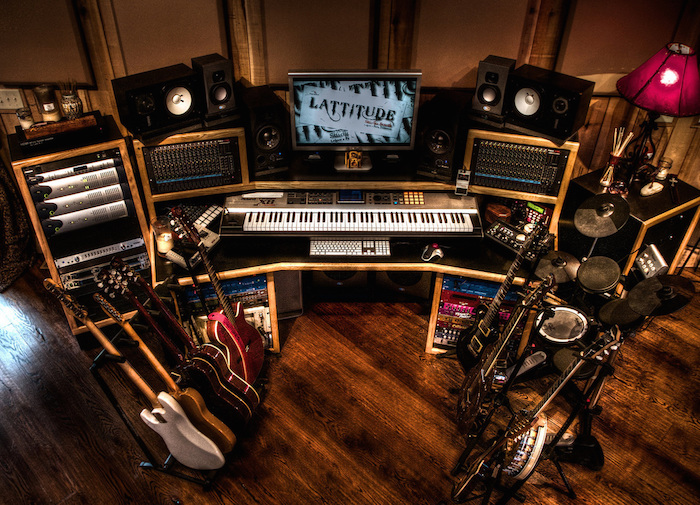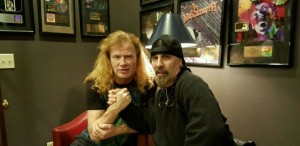Recording Retreat: Lattitude Studio South, Leiper's Fork, TN
As practitioners of sound, there is a phenomenon that plagues us all at one point or another in our careers: GAS.
No, I’m not referring to that feeling of discomfort that comes after consuming too many legumes. I’m talking about Gear Acquisition Syndrome.
This familiar complex, which fuels our unquenchable longing to acquire more and more audio equipment, has the potential to be quite expensive and unfortunately, it cannot be cured with any amount of Beano.
With that in mind, I’d like to introduce Mr. Michael Lattanzi, owner of Lattitude Studio South, who proudly embraces his extreme case of GAS. There seems to be no end in sight to his ever-growing gear collection, and he doesn’t seem to be seeking any treatment for his condition.
While the average gear maniac gets excited about adding another pedal, microphone, or piece of outboard to the collection, Lattanzi has bigger fish to fry: He’s a collector of consoles, and not one, but four iconic desks can be found at Lattitude.
In 2011, Michael and his wife, Kathy, relocated to Tennessee, just outside of Music City. It is here that Lattanzi brought his own personal recording retreat to life. This gorgeous 3,000 sq ft facility was built to his specifications by John Carter of Unity Construction and the wiring was designed by Scott Hasson of West Coast Studio Services. Since its construction, Lattitude Studio South has already hosted artists including Megadeath, Hunter Hayes, Thompson Square, Elle King, Blues Traveler, and Brad Whitford of Aerosmith.
Nestled atop a hill on the outskirts of Nashville, Tennessee in a small rural village called Leiper’s Fork, Lattitude offers a sense of tranquility and exclusivity that is second to none. With only 650 residents scattered about roughly 1,100 rolling acres, Leiper’s Fork presents privacy and scenic beauty, both in great abundance.
This is one of those refreshing places where you might drive for several miles through winding roads, hills, and trees and not see a single home or building.
Lattitude itself is so far off the beaten path that after a long scenic drive out to the studio, when you finally hear that familiar voice declare that “you’ve arrived at your destination,” you will find that you have merely arrived in front of a big dead oak tree in the middle of nowhere.
Pinpointing the exact studio location from here required this visitor several wrong turns, and a phone call to the studio owner himself. It is a location so remote, that not even Google knows where you are.
Upon reaching the studio, visitors are greeted with an overwhelming sense of peace and calm. But if you thought the hilltop view was ridiculous, wait until you step into the control room.
Control Room
In a world where more and more studios gravitate toward control surfaces, touch screens, dongles, and other doodads, Lattanzi spared no expense to ensure a zero-compromise analog solution in equipping the heart of his studio.
In a horseshoe formation in the center of Lattitude’s nearly 1,300 sq ft control room sits not one, but three iconic consoles: An API-1604, a Neve 8078, and an SSL E/E/G+. And as if the three beastly consoles weren’t enough, Lattanzi’s favorite desk—another early 70’s 40 input API—is stored away in the garage. “I couldn’t fit it in here too. Maybe one day if I downsize, that’ll be my primary desk.”
On several occasions, Lattanzi has been offered sums in excess of a quarter million dollars for his prized Neve 8078. That’s a tough offer to say no to, but Lattanzi couldn’t imagine parting with the desk.
“My pride and joy are drums, and everyone who works here raves about the drum sounds. It’s my favorite drum room hands down, and it just sounds so amazing coming through the 8078.”
Live Room
Natural outdoor light pours into Lattanzi’s studio through large glass windows, offering further warmth to the already-inviting log cabin feel of the tracking area. He says that his little slice of paradise offers differing views depending on the seasons: The summers bring the shade and privacy of the thousands of surrounding trees, and when the leaves fall in autumn, you are exposed to the winding roads below and the beautiful hilly country side.
This facility itself, like the surroundings, comes across as immaculate. The studio is smartly furnished with Latch Lake stands with attached boom arms to minimize clutter. Lattanzi also employs several snakes to avoid the typical studio mess of XLRs all over the floor.
One unique feature of Lattitude Studio South by Nashville standards is its lack of iso booths. Initially, booths were part of the plan, but Lattanzi was getting eager to work and just wanted to finish the studio. Looking back, he says he is glad to have left the large live space untouched, as he’s fallen in love with the big open drum sounds the room affords in its current configuration.
While tie lines exist throughout the structure, meaning that isolation can be achieved for live tracking situations, he doesn’t want to alter the acoustic character he’s come to love, and says that any plans to build “proper” iso booths to accommodate the more conventional Nashville-style approach can wait.
This hasn’t been a problem for Lattanzi’s own approach, as he generally prefers to dedicate days to each of the individual elements of a recording anyway: a day for drums, a day for bass, a day for guitars, and so on.
“Making records, I like to spend a day with the bass player, writing hooky bass lines, and having fun, and getting to know the artist and making an event and experience out of the entire thing. You know, something to remember the rest of your life—a good experience.”
Foundations
Music does form memories, and Lattanzi still remembers his first real exposure to the art form. “My parents took me to see the Beatles at Shea Stadium when I was 4 years old,” he says “and that moment has been stuck in my brain ever since. I still remember it like it was yesterday.”
From that moment on, Lattanzi couldn’t get music out of his system. Some time later, when hew was in the 5th or 6th grade, his sister taught him a few chords on guitar, and he recalls sitting alone in his room trying to develop his newfound passion.
“I went to see my friend Doug Hochlerin and his band Mazarin play, and he got all the women, and stuff, and I was like, ‘I want to be that guy,’ which I hate to admit. But I’d see him play cover gigs, and then I’d go home and try to remember what he played.”
Lattanzi says he pursued music more for the love of the craft than for any promise of money, and remembers his “big break” with some mixed feelings:
“I thought I’d really made it at first when I got my deal with MCA. I had a top-10 club record come out in 1989, it was along the lines of Depeche Mode, New Order, that kind of stuff…
“I got an advance, you know, and I got a bunch of money, and I’m like oh I got paid, this is cool! But even before that I had songs in TV shows and movies and I had income coming in finally, and I’m like oooh, I’m getting paid for this. Then I saw myself on TV and was like ‘What a stiff!’ I looked like an idiot.”
Feeling discouraged, Lattanzi nearly left the music business all together, “Fortunately I had very supportive friends and family who urged me to continuing working in music.”
It was around this time that Lattanzi’s brother-in-law, the Toronto based producer, Dave Tyson, heard some demos he’d done for a group that would eventually become The Fugees.
Tyson was impressed, and from there, a working relationship was born. One of Lattanzi and Tyson’s first collaborations was for a Canadian artist by the name of Amanda Marshall. The record was a quick success, spawning six top-40 hits in Canada.
“In no time I went from living with mom in New York to being able to buy a house in the Hollywood hills. It was a shock to the system.”
Around that time, Lattanzi reconnected with an old friend from New York, Evan Lamberg of EMI. Through Lamberg, Lattanzi had the opportunity to work with acts including Paula Abdul and Jewel. His reputation as an engineer and producer quickly grew and he began receiving calls from The Goo Goo Dolls, LL Cool J, Smash Mouth, Lindsey Lohan, and even Paris Hilton.
Everything was on the up and up until Lattanzi fell off a cliff while mountain biking in 2006, shattering his spine and leaving him confined to a wheelchair.
Shortly after the accident, Lattanzi and wife Kathy moved to Sedona, AZ, to get out of L.A. and allow him the opportunity recuperate.
For nearly three years Lattanzi kept his involvement in the music industry to a minimum. During his hiatus, he did mix some Chicago and Doobie Brothers projects, and continued to have songs appear in TV and movies, but confesses that his Sedona studio was mostly neglected.
This long departure from his passion left him depressed, and he knew he needed to make records again. Lattanzi decided to roll the dice with his life savings to pursue his passion again, but he admits relocating to Music City wasn’t his first choice. “My wife is from L.A., so she was like, ‘anywhere but L.A..’” When Kathy suggested Nashville, Lattanzi’s first response was, “What are you, nuts?”
Despite his wife’s wishes, Lattanzi began searching for studios and homes in L.A., thinking that when he found the right one, they’d just have to fight it out. But soon after, Lattanzi came to realize and acknowledge that Kathy had been there for him through it all, even acting as his caretaker during this recovery process.
“I decided that if that’s what she wants, I’ll give it a shot.” Fast forward five years and now Nashville feels like home.
Studio Life
I’s been nearly 10 years since Lattanzi’s crippling mountain-biking accident, and while he’s regained a fair amount of mobility, he still faces a everyday challenges:
“At first, I attended therapy regularly, and I was progressing. It’d be ideal if I would just get up every morning like an athlete and workout, then go to therapy, and get myself out of this wheelchair, but in order to do so, I’d have to put the music on hold. I was devastated when I wasn’t working on music, and I’ve even thought, if I had to lose all of this to regain the ability to walk, I wouldn’t trade it.”
Lattanzi doesn’t discriminate when it comes to a preferred musical genre. Speed metal, country, pop, rock, R&B. “It’s all about staying current and knowing what’s out there. If a young kid walks in the door and mentions a band, I need to know who that is, so everyday is an exercise in staying current.”
Lattanzi began working for Arista Records in the 80’s, and it was there that he learned the art of crafting a captivating song. When producing a new act, he says he’ll live in that specific genre for the duration of the project and likes to dive into each and every project with a passion as if it were his very own.
“I’ve kind of gotten spoiled with the luxury of having all the time I want or need to craft sounds,” he says, and prefers to meticulously craft every element in a mix until it is perfect by his standards.
Though he admits he is capable of working very quickly if needed, he says that the ability to focus on the product, instead of the clock, that he is afforded by having his own studio has been very refreshing. This luxury requires him to impose limits on himself, as he often finds himself getting swept up into each project.
“Sometimes I’ll get caught up and spend 5 days on a mix,” and he often prints mixes directly back into Pro Tools as well as his Studer A8 RC MK II 1/2” machine, just to see which treatment works for the track.
“I like to hear the instruments in the environment first, and how they’re reacting with the acoustic space. Then I get back into the control room and try to do that justice.
“One thing I always try to avoid is working in solo,” he says. “It just slows the process down, and prevents you from hearing the big picture. It’s all about context.”
Tricks of the Trade
Though Lattanzi says he never likes to fall into a mundane routine, or apply the same kinds of treatments to every project we all still have our “go to” chains when tracking and mixing, and I convinced Lattanzi to open up about some of his.
One interesting technique that he likes to employ while tracking, is to have the 2-mix from his Neve console feed into his the SSL bus compressor, followed his C Gray custom telescopic EQ’s.
“In this situation I like to compress before I EQ, because I don’t want my EQ to impact how the compressor is working.”
By beefing up the 2-mix right out of the gate, he notes that everything sounds larger than life before employing any further signal processing to individual tracks.
As for his favorite vocal microphone, Lattanzi confesses his lust for a Telefunken 251; but since he’s yet to add one to his mic locker, he notes that the substantially more economical SE Gemini II has been doing the trick lately.
Even after achieving success as a major label artist and producing and engineering for some iconic acts, Lattanzi still credits Lattitude Studio South as the highlight of his career.
“I’m grateful for the opportunities and the success I’ve experienced, but coming to Tennessee, and overcoming this traumatic accident has been a huge victory for me. I could have given up and sat and cried over spilled milk, and concluded that my life was over, but instead I flipped it and built the best studio I’ve ever been in in my life.”
Lattanzi was emphatic about wanting to share his facility with like-minded musicians. “I’m as approachable as it gets. If someone wants to come here, and for me to produce, engineer, and mix a project; it’s a no brainer.” Though Lattitude serves as Michael Lattanzi’s own private office, where he often produces, engineers and mixes entire projects, he is open to making the space available to other engineers and producers as well.
“I just want to stress the point that I want to share this place. I built it for me, so it’s not a ‘commercial’ facility by any means—I’m not trying to compete with the studios in town, at all. I just want to surround myself with great people who can enjoy this as much as I do.”
If you ever doubt the severity of Lattanzi’s gear acquisition syndrome, Lattitude’s gear list follows below.
CONSOLES
Neve-8078
SSL-SL4000 E/G/G+
API-1604
TAPE MACHINES / DVD / CD
STUDER A827 – 24 track / 2” machine. (30 / 15 ips)
STUDER A80 RC MK II – 1/2” Two Track (30 / 15 / 7.5 ips)
TACAM DV-RA1000
HHB CDR-800 CDR
PANASONIC SV-3800 DAT Machine
TASCAM 122MKII cassette deck
SIGNAL PROCESSING
Lexicon – 960L Digital reverb / Effects
Lexicon – 480L Digital reverb / Effects
Lexicon – 200 Digital reverb
Lexicon PCM-70 Digital reverb / Effects
lexicon PCM-60 digital reverb
Lexicon PCM-42 Digital Delay
Yamaha SPX-90ii digital effects processor
Ibanez -dm-2000 digital effects processor
PRE/EQ/COMPRESSORS
Arsenal Audio MP-20 mic pre amp
Avalon vt-737 sp
Neve 1080 mic pre / eq
(2) Warm audio TB-12 tone beast mic pre’s
(4) C Gray custom Telescopic eq’s
(2) Warm audio EQ-WA eq’s
SSL stereo bus compressor
Alan Smart c2 stereo compressor
(2) Urei LA-3A Audio Leveler
(2) 1957 Gates Sta Level comp / limiters
(2) Empirical Labs Distressor el-8
(2) Empirical Labs Distressor el-8x
Summit Audio DCL-200 dual comp / limiter
(6) Warm audio WA-76 compressors
(12) dbx 160- Xt’s
(4) dbx 160- X’s
(4) dbx 160- A’s
dbx-166 stereo comp / gate
(3) Inward Connections Vac Racs:
Vac Rac – 1 / (4) Tube step Eq’s
Vac Rac – 2 / (4) tube mic pre’s
Vac Rac – 3 / (4) tube limiters & (2) tube Direct Boxes
MONITORING
(6) Pair Yamaha NS-10M
(4) Pair ADAM a7
JBL LSR 4326-p monitors
Eve SC407 monitors
Dynaudio M1.5 studio monitors
(3) pair Blue Sky studio monitors
Hafler studio monitors
Auratone sound cube
(2) Miller & Kreisel MX-350 powered subwoofers
JBL LSR 4312-SR powered subwoofer
(3) Blue Sky powered subwoofers
Jasper LeMaster is a staff engineer at Ocean Way Studios in Nashville, TN.







